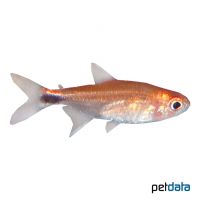Ruby Tetra (Axelrodia riesei)
| Ruby Tetra Axelrodia riesei | |
|---|---|
| Name | Ruby Tetra |
| Name Lat. | Axelrodia riesei |
| Family | Characins |
| Family lat. | Characidae |
| Order | Characins |
| Order lat. | Characiformes |
| Origin | South America |
| Habitat | Forest streams |
| Diet | Carnivore |
| pH | 4.0-6.5 |
| Behavior | Peaceful |
| Keeping | Group |
| Care Level | Difficult |
| Reproduction | Egg scatterer |
| Breeding | Difficult |
| Life Span | 3-5 years |
| Protection | No |
| Metric Units | |
| Size | 2-3 cm |
| Temperature | 20-26 °C |
| Hardness | 1-5 °dH |
| Aquarium | 40 l |
| US Units | |
| Size | 0.8"-1.2" |
| Temperature | 68-79 °F |
| Hardness | 18-89 ppm |
| Aquarium | 10 gal |
Distribution and habitat
Red semolina tetras are native to the upper Rio Meta drainage, east of Villavicencio in southern Colombia. They live in the brown, humic acid-rich water (blackwater) of slow-flowing small forest streams with dense riparian vegetation.
Maintenance
The aquarium should have a varied, partly dense planting, with shelters and hiding places (roots) and provide sufficient swimming space. A dark substrate covered with some foliage (e.g. sea almond leaves), shaded light (floating plants) and soft, slightly acidic water as well as a weak current is ideal.
No ammonia, ammonium and nitrite should be detectable, the nitrate value should not exceed 100 mg/l. To ensure the water quality and oxygen content, a filter and heater adapted to the aquarium size is required, as well as lighting for the species-appropriate day-night rhythm of the animals.
Diet
In nature they feed mainly on small insects and larvae. The food supply consists of live or frozen cyclops, daphnia, artemia, moina, mosquito larvae, etc. or a commercially available frozen food mix for nano fish. High-quality, protein-rich dry food, such as micropellets or fine flake food is also well accepted.
Only feed as much as is eaten immediately (in a maximum of 10 minutes). Regular and varied feeding promotes health and increases resistance. 
Behaviour and compatibility
These peaceful and sociable fish should be kept in a group of at least 8-10, but preferably more. They are very suitable for a nano tank and can be socialized well with other peaceful fish of similar size
Basically, only compatible fish species with similar requirements for water conditions and water temperature should be socialized.
Sex dimorphism
The males are more slender and intensely colored than the round-appearing females.
Reproduction and breeding
There are isolated reports of successful breeding in the aquarium.
Important
They show their most beautiful coloration in very soft, acidic water and by feeding on live food
The foliage (sea almond tree, oak, etc.) not only provides cover, it enriches the water with humic substances, naturally lowers the pH and, when rotting, promotes the development of microorganisms, which are a valuable secondary food source.
The well-being of the fish should be monitored regularly. Temperature should be checked daily, pH, hardness and nitrate levels at least every 14 days. Regular partial water changes are recommended, even when contaminant levels have not yet reached the upper limit. Sudden changes in water quality should be avoided. Newly introduced fish must be accustomed slowly to the water in the aquarium.
Further literature can be found in your pet store.
References
Text: Werner Winter; Image: petdata
Source: BMELV (1998): Tierschutzgutachten - Haltung von Zierfischen (Süßwasser); RIEHL & BAENSCH (2006): Aquarien Atlas Bd. 1, Mergus Verlag; ENGELMANN (2005): Zootierhaltung - Tiere in menschlicher Obhut: Fische, Verlag Harri Deutsch
- Gemäß § 21 Abs. 5 Tierschutzgesetz idgF
